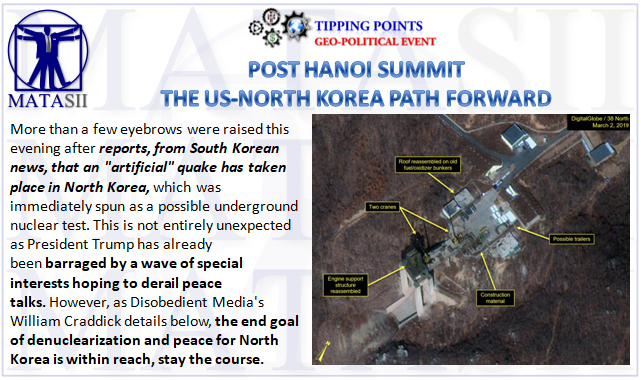POST HANOI SUMMIT: THE US-NORTH KOREA PATH FORWARD
A PUBLIC SOURCED ARTICLE FOR MATASII (SUBSCRIBERS & PUBLIC ACCESS) READERS REFERENCE
SOURCE: 03-07-19 - "Craddick: Today's Korea Quake & The Path Forward After The Hanoi Summit"
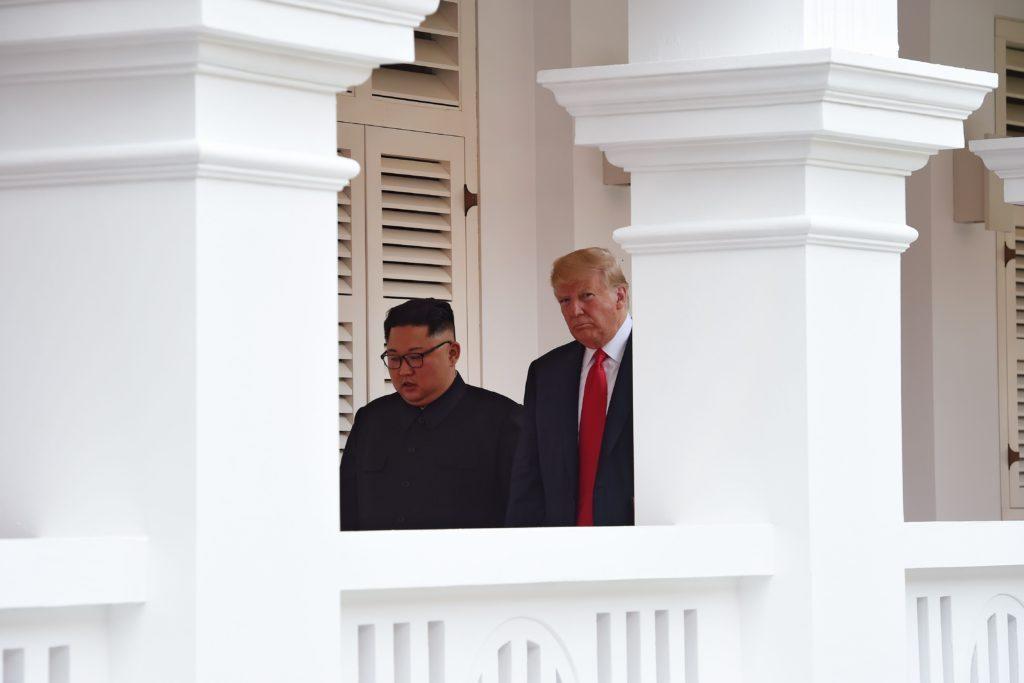
SOURCE: 03-06-19 - "Suspicious Activity Detected At Facility Tied To North Korean Missile Program"
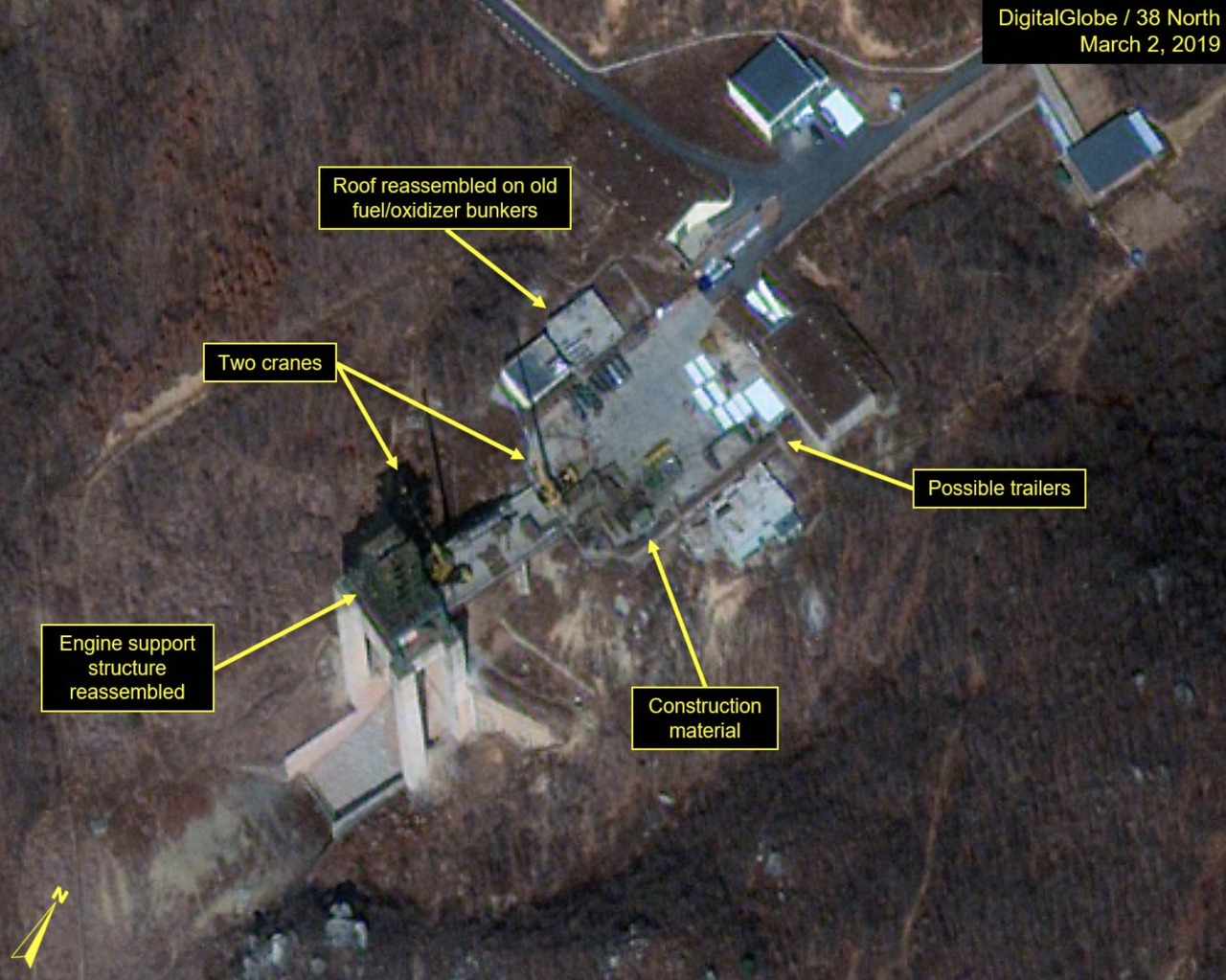
SOURCE: 03-07-19 - "North Korean Long-Range Missile Site Appears Operational, Analysts Say"
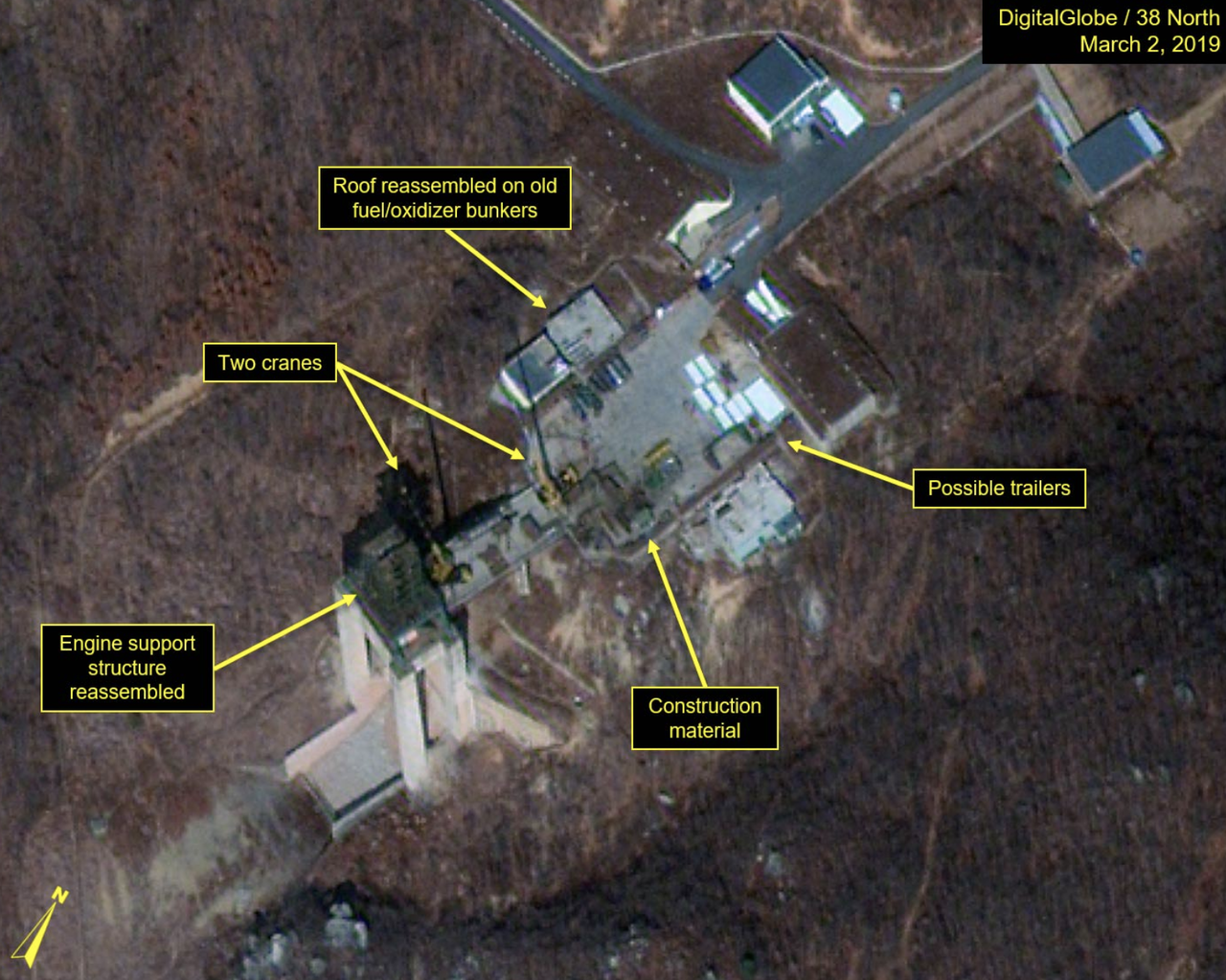
SOURCE: 03-07-19 - ""Artificial" Magnitude 2.1 Earthquake Detected In North Korea"
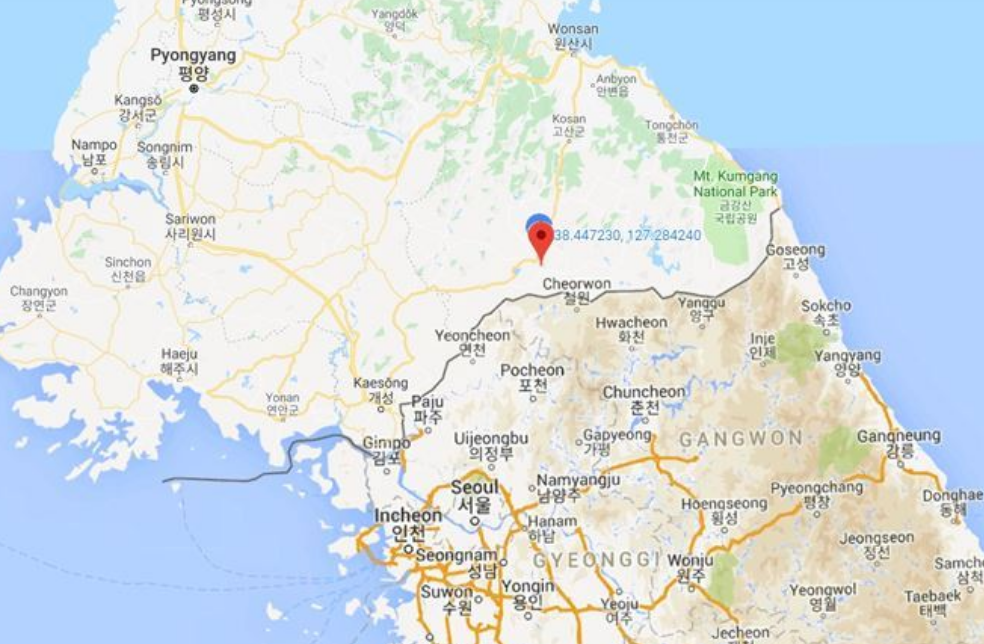
More than a few eyebrows were raised this evening after reports, from South Korean news, that an "artificial" quake has taken place in North Korea, which was immediately spun as a possible underground nuclear test. This is not entirely unexpected as President Trump has already been barraged by a wave of special interests hoping to derail peace talks. However, as Disobedient Media's William Craddick details below, the end goal of denuclearization and peace for North Korea is within reach, stay the course.
Although the Hanoi Summit did not result in a signed deal between the negotiating teams, both North Korea and the United States should not come away from their meetings discouraged. As President Donald Trump said during a post-Summit press conference, both parties have come away with the information they needed to understand each other’s perspective. An agreement is within reach if dialog is continued with adequate frequency.
With proper planning for the next meeting between the leaders of the United States (US) and the Democratic People’s Republic of Korea (DPRK), proper perspective for Chairman Kim Jong Un and cooperation from the Global Powers the mutually beneficial goal of denuclearization and an end to hostilities in the Korean Peninsula is within sight.
I. Feedback On Hanoi
The length of negotiations were unfortunately hampered not only by partisan bickering at home, but also the looming threat of the nearby border war that was breaking out between India and Pakistan as well as apparent harassment of North Korea by intelligence agencies.
Both President Trump and Chairman Kim also miscalculated in their approach to negotiations. Kim’s insistence that sanctions be dropped before denuclearization was an unrealistic expectation borne out of North Korean fears of a potential US invasion that failed to account for US sensitivities about previous North Korean failures to conform to past agreements between the members of the Six Party Talks. Trump’s modus operandi of walking from negotiations to increase pressure and the likelihood of a favorable deal was also an unnecessary solution to a problem that could have been resolved by an extension of the Summit’s timeframe to hammer out points of contention.
None of these mistakes were terminal however, and there is a very clear road forward towards peace and stability.
II. Recommendations For Future Summit
To overcome the stumbling block that hampered a total success in Hanoi a step by step process for denuclearization must be laid out. The most logical method of execution would be to agree to a road plan whereby North Korea would progressively disarm specific sites and dispose of weapons systems, verified by outside inspection. In return, the US would remove specific sanctions as benchmarks are met. Such a clear and controlled process will help boost North Korean confidence in the intention of the United States to deal fairly in relation to sanctions and assuage US fears about any unfaithful dealing by North Korea. If an agreement that allows for the DPRK to retain a limited number of nuclear weapons is reached it will need to include arrangements for routine inspections to ensure that the ordinance can be tracked to the satisfaction of the international community.
Any deal that is reached must include a signed agreement by the United States pledging not to attack the DPRK or overthrow Kim Jong Un. Ideally, such promises would also be accompanied by a framework outlining the ways in which the United States will assist North Korea with economic development. Because North Korea’s pursuit of nuclear weapons was incentivized by fear of foreign invasion by the US there must be assurances, publicly memorialized in writing, to reduce these kinds of tensions. These promises should not necessarily be expected to include the removal of American troops from South Korea since their presence is aimed to protect South Korea and Japan from a hypothetical invasion by China. As such an invasion would also necessitate the occupation of North Korea, the US deployment in South Korea also provides an element of security to Kim Jong Un, his people, and government.
Although the process of nuclear disarmament is a priority that must be resolved before other concerns, a formal ending to the Korean War must also be a primary objective of both the DPRK and the United States. If both parties were to schedule disarmament strategically there is an outside possibility that the next summit could include the signing of an armistice. The choice of Seoul as the location for the next summit would also allow for representatives of South Korea and China to be present in the event that denuclearization talks had progressed satisfactorily to the point that the topic of the Korean War could be properly broached. Hosting a summit in Seoul would also create an opportunity for Kim Jong Un and President Moon Jae-in to discuss various issues relating to inter-Korean affairs and future partnerships as relations continue to warm.
III. Recommendations To Chairman Kim Jong Un
The young leader of North Korea certainly did not ask to come to power in the manner that he did and has faced a number of challenges while navigating power struggles and grappling with a country suffering from isolation and collapsing infrastructure. Kim Jong Un has an unprecedented opportunity to show the world that he will be a truly great ruler of North Korea that will take them from a hermit kingdom to a regional powerhouse on par with their southern neighbor. Steps that Chairman Kim could take towards this goal include voluntary denuclearization and an international diplomacy campaign to build new bridges and put his country on the map geopolitically.
A. Voluntary Denuclearization
Pre-emptively taking steps to denuclearize certain sites in the DPRK would be a maverick move from a country that has long caused consternation to its neighbors by behaving unpredictably. Such actions would also help North Korea make a stronger case to their American counterparts for progressively removing sanctions in return for verified movement towards denuclearization.
It is a common trope amongst some political commentators that North Korea sought nuclear weapons with the primary goal of using them as a deterrent against the United States. But as journalists such as Julian Assange have correctly noted, North Korea’s WMD stockpiles were primarily acquired due to their fears of strategic threats from China. Chinese troops have already once become a de facto occupier of North Korea during the Korean War. Establishment media outlets such as Foreign Policy have also openly advocated for Chinese troops to occupy North Korea in recent years. Korea has a long history with China, which has generally ruled the region as a pseudo-vassal state in a similar manner the other areas such as Tibet and Xinjiang. There is little doubt that any direct Chinese military involvement in North Korea would lead to disastrous policies of Hanification in the region. It is through this lens that the DPRK’s behavior must be interpreted.
B. Nuclear Technology Acquisition
North Korea’s nuclear technology sounds worrying when described in lurid headlines, but the reality is that their stockpiles are more of a risk to themselves than the countries they supposedly would use them to attack.
North Korea is notoriously cash starved, but their communist economy has been effective at producing conventional weaponry en mass. It is this one overabundant resource that has allowed the hermit kingdom to strike the deals needed to acquire second hand nuclear technology. Nations who have seemingly engaged in such transactions with the DPRK generally appear to be Middle Eastern and include Syria, Iran and potentially Egypt. This policy has also created some significant liability for North Korea, as the weaponry they sell often ends up on the black market or in the hands of rebel and terror groups which creates a chain of attribution tying the DPRK to organizations engaged in activities which they never had any intention of supporting.
- Syria - As outlined by the Council on Foreign Relations’ Foreign Affairs, North Korea has had a collaborative relationship with the Syrian government since the 1960’s which has involved the frequent sale by the DPRK of conventional weaponry and missiles. It would appear that the terms of these sales included arrangements to transfer nuclear technology. In 2004, World Tribune reported the deaths of several technicians from the Syrian Scientific Studies and Research Center, an institute responsible for the research and development of nuclear, biological, chemical and missile technology and weapons, in the Ryongchon province of North Korea. In 2008, Japanese national public broadcaster NHK cited South Korean military sources who stated that as many as ten North Koreans may have been killed in an Israeli airstrike of a facility in Deir ez-Zor, Syria that was allegedly a secret nuclear reactor capable of producing plutonium.
- Iran - Iran and North Korea have also enjoyed a close relationship since the Iran-Iraq war, where North Korea began selling conventional weapons and military technology to Iran while also providing military advisors. The business relationship has opened another avenue for North Korea to acquire nuclear technology. A 2003 report by the Los Angeles Times highlighted the Iranian government’s connections to nuclear programs in Russia, China and Pakistan as well as North Korea. While the first three had long-established nuclear programs at the time, North Korea did not. This provides yet another indication that conventional weapons and technology transfers by the North Korean government were made with the goal of acquiring nuclear materials, technology and know-how.
- Egypt - A third potential venue for the DPRK to barter for hand-me-down nuclear technology was Egypt. According to the Federation of American Scientists, Egypt launched a nuclear program in 1954, but shifted their focus to research and civilian applications in 1967 after being defeated in the Six Day War. Much like with Syria and Iran, Egypt has a long-standing military and diplomatic relationship with North Korea that has drawn the ire of the United Nations. Although their nuclear reactors were originally provided by the Soviet Union, Egypt has also acquired reactors for research purposes from other countries such as Argentina as recently as 1992. Given the long history of weapons sales by North Korea to Egypt, both directly and indirectly through brokerage services, it is likely nuclear technology transfers could have occurred in the course of these dealings.
C. North Korea’s Nuclear Weapons And Technology Are A Danger To Itself
Although North Korea believes their nuclear stockpiles are a deterrent, they are actually a double-edged sword that places them in danger because of the risk posed by the radiation they create as well as the fact that the mere possession of such assets will make the DPRK a target in the event of any nuclear war between the great powers that would suck them into a conflict they cannot win.
Because of the aged condition of the technology purchased second-hand by the DPRK to develop nuclear capabilities it is likely that the radiation risk to the entire country is high. The many failures of North Korea’s missile tests have long been noted by Western and international media. Considering the run down materials and apparently shoddy construction of nuclear facilities, reactors and, missile technology there is a very real possibility that some of the North’s nuclear weapon “tests” were in fact accidental explosions. The potential for another disaster on the scale of Chernobyl or Fukushima may be far higher than publicly acknowledged.
The risk of radiation poisoning to North Korea’s population could also be extreme based on the record high statisticsof cancer death rates in South Korea. Additionally, if the death of Kim Jong Il was in any way aggravated by radiation exposure, then the risk to Kim Jong Un’s health in the long term could become a concern for the overall wellbeing of his country.
Nuclear weapons provide North Korea with a false sense of protection. In the event that war might break out between North Korea and one of the Great Powers or between the Great Powers themselves the policy of Mutually Assured Destruction (MAD) would ensure that North Korea would become a target for multiple nations with more nuclear and conventional firepower than it could ever hope to muster in return.
The possession of nuclear weapons is not a fix-all for North Korea and would in fact doom them to destruction in the event of a war. North Korea might fear that to relinquish them would condemn the country to the same fate as Libya or the Ukraine. But North Korea does not play into any strategies relating to regional destabilization like Libya or Venezuela. Nor does it factor into long term expansion plans for organizations like NATO. There is far more to gain by reducing or totally eliminating stockpiles of nuclear weapons than there is to retain them.
D. A Diplomatic Charm Campaign
Kim Jong Un is a man who is happy while traveling abroad, but who seems to merely be going through the motions when at home in a nation whose infrastructure is built with relics of the Japanese and Soviet eras. Embarking on a series of outreach efforts to project a more positive image of North Korea, build diplomatic ties and lay the groundwork for the establishment of embassies around the world is a much needed first step in transforming his country. Meetings with European and Asian leadership will be essential if Kim wishes to communicate that the DPRK is open for business. Such a campaign could also include a historic visit to the White House in the same manner as the 1987 summit between General Secretary Mikhail Gorbachev and President Ronald Reagan near the end of the Cold War.
IV. Recommendations To The Big Three Powers
With Trump’s walk-away in Hanoi, Russia and China have a fresh opportunity to step into negotiations and win a PR victory that will ultimately help make the world a safer place. All three great powers have the necessary experience working with WMDs and considerable incentive to peacefully eliminate the threat from North Korea. Yet only the United States has stepped up to the plate to do the heavy lifting involved with the process. Russia and China must begin to understand the benefits they stand to gain from assisting the DPRK on the path to peace.
China’s incentive to bring peace and stability to the Korean Peninsula is one that plays into their long term geopolitical goals. Actions taken to help solve the crisis would allow Beijing to recuperate their image around Asia, particularly after years of contentious strife with countries such as Japan, the Philippines and Vietnam over territorial water disputes. Proof that China can resolve their conflicts peacefully will speak far louder than any words will be able to.
Russia also has every reason to take an increased role in the peace process since they have begun to build a reputation as a stabilizing global power after their intervention to prop up the Syrian government of Bashar al-Assad in the Syrian civil war. Their cooperation with North Korea would create a new avenue for economic cooperation within the DPRK, whose economy is being eyed by many different corporate interests that hope to secure lucrative deals while assisting with infrastructure and trade development.
V. Conclusion: Stay The Course, Ignore Naysayers
It is little surprise to see that in the aftermath of the Hanoi Summit, President Trump has been barraged by a wave of special interests hoping to derail peace talks. This is very much analogous to the pressure that was placed on President Ronald Reagan in the aftermath of the 1986 Reykjavík Summit. Trump’s response must be, like Reagan’s, to ignore it and persevere.
Institutions such as the Heritage Foundation have already begun baying for a return to hardline policies that will stifle any hope of a future deal. In the media, NBC News, an outlet that previously worked with the CIA and parts of the defense industry to undermine Korea negotiations, has once again been active in using any imaginable excuseto argue against the peace process. These distractions detract from the promising future of a prosperous, peaceful Korean Peninsula that no longer is a liability to the world, but an asset.
Chairman Kim Jong Un must continue with open arms to work with the global powers and the DPRK’s neighbors to pursue denuclearization and an armistice. President Trump and Kim walked away from Hanoi with a continued feeling of goodwill and a clear vision of each other’s perspectives and desires. This understanding must be built on to achieve a total success that will become the toast of the international community for years to come.
FAIR USE NOTICE This site contains copyrighted material the use of which has not always been specifically authorized by the copyright owner. We are making such material available in our efforts to advance understanding of environmental, political, human rights, economic, democracy, scientific, and social justice issues, etc. We believe this constitutes a 'fair use' of any such copyrighted material as provided for in section 107 of the US Copyright Law. In accordance with Title 17 U.S.C. Section 107, the material on this site is distributed without profit to those who have expressed a prior interest in receiving the included information for research and educational purposes. If you wish to use copyrighted material from this site for purposes of your own that go beyond 'fair use', you must obtain permission from the copyright owner.
NOTICE Information on these pages contains forward-looking statements that involve risks and uncertainties. Markets and instruments profiled on this page are for informational purposes only and should not in any way come across as a recommendation to buy or sell in these assets. You should do your own thorough research before making any investment decisions. MATASII.com does not in any way guarantee that this information is free from mistakes, errors, or material misstatements. It also does not guarantee that this information is of a timely nature. Investing in Open Markets involves a great deal of risk, including the loss of all or a portion of your investment, as well as emotional distress. All risks, losses and costs associated with investing, including total loss of principal, are your responsibility.

